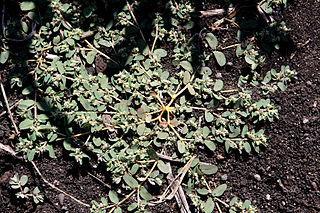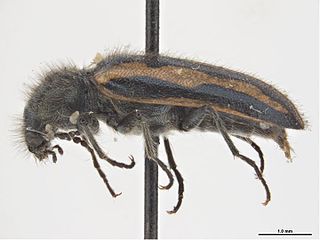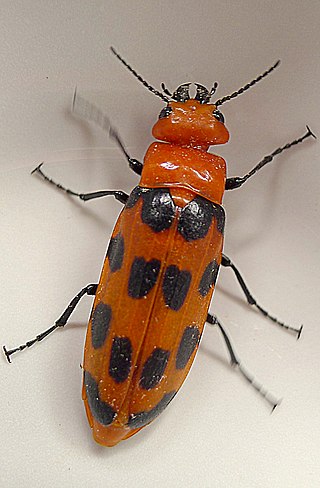
Euphorbia maculata, known as spotted spurge, prostrate spurge, milk purslane, or spotted sandmat, is a fast-growing annual plant in the family Euphorbiaceae. While it is native to North America, where it is a common garden and lawn weed in the United States, it has become a common introduced species throughout the world, including Europe, Japan, Korea, Australia, and New Zealand.

The spotted houndshark is a houndshark of the family Triakidae found in tropical waters in the eastern Pacific Ocean off the coast of South America. It usually grows to a length around 180 centimetres (71 in). The reproduction of this houndshark is ovoviviparous, with a litter of 14 pups being found in one female with a birth size of 30 to 40 centimetres. Their diet is believed to consist mainly of crustaceans.

Corymbia maculata, commonly known as spotted gum, is a species of medium-sized to tall tree that is endemic to eastern Australia. It has smooth, mottled bark, lance-shaped to curved adult leaves, flower buds usually in groups of three, white flowers and urn-shaped or barrel-shaped fruit.

The Pediciidae or hairy-eyed craneflies are a family of flies closely related to true crane flies, with about 500 species worldwide.

Dicranota is a genus of flies in the family Pediciidae.

Lophocampa maculata, the Yellow-spotted tussock moth, mottled tiger or spotted halisidota, is a moth of the family Erebidae and the tribe Arctiini, the tiger moths. The species was first described by Thaddeus William Harris in 1841. It is found across Canada, the western parts of the United States, south in the Appalachians to South Carolina and Kentucky. They are also found in Southeastern Alaska.

The blotched snakehead is a species of snakehead. It is one of four species of the genus Channa native to China. It is also native to northern Vietnam and Taiwan, but has been widely introduced to other countries, where it is an invasive species. This predatory species typically grows to a length of 20–30 cm (7.9–11.8 in), but it has been confirmed at 33 cm (13 in) and some suggest it may reach a far larger size.
D. maculata may refer to:

Psoa maculata is a species of horned powder-post beetle in the family Bostrichidae. It is found in North America.

Mangora maculata, the greenlegged orbweaver, is a species of orb weaver in the spider family Araneidae. It is found in the United States.
Itolia maculata is a species of robber flies in the family Asilidae.
Sibinia maculata is a species of leguminous seed weevil in the beetle family Curculionidae.
Grammonota maculata is a species of dwarf spider in the family Linyphiidae. It is found in the United States and Costa Rica.

Zacosmia is a genus of cuckoo bees in the family Apidae, containing one described species, Zacosmia maculata.
Epicauta maculata, the spotted blister beetle, is a species of blister beetle in the family Meloidae. It is found in Central America and North America.

Ceraclea maculata is a species of long-horned caddisfly in the family Leptoceridae. It is found in North America.
Ephemerella maculata is a species of spiny crawler mayfly in the family Ephemerellidae. It is found in North America.

Cissites is a genus of blister beetles in the family Meloidae. There are at least four described species in Cissites.
Therioaphis is a genus of aphids in the family Aphididae. There are more than 20 described species in Therioaphis.
Tapinella maculata is a species of thick barklouse in the family Pachytroctidae. It is found in the Caribbean Sea, Central America, North America, and South America.











